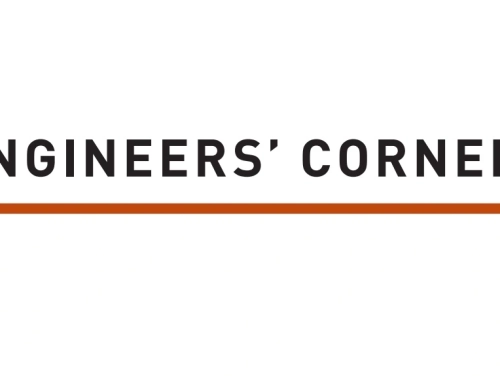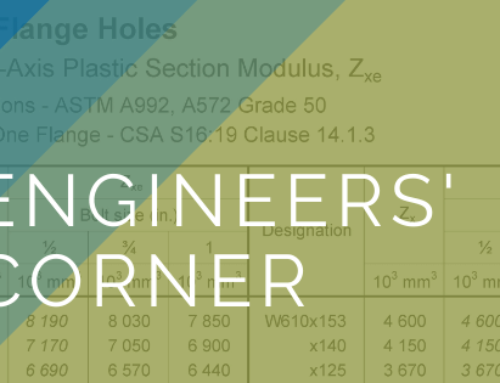Special Topic – Advantage Steel Issue No. 52
Over the last two decades, the advent of modern steelmaking technology has economically raised the strength levels of common structural steel products. Other important characteristics of new steel products and grades, including tighter control in chemical composition and mechanical properties, have also improved. Moreover, producers have added significantly larger sections, eliminating the need for costly built-up sections in many applications. This article briefly examines some of the changes and improvements introduced to various common steel products and grades available in Canada today.
Wide-Flange Shapes
ASTM A992/A992M: In North America, W-shapes are produced, in compliance with ASTM A992/992M, to a specified minimum yield stress (Fy) of 345 MPa and a specified minimum tensile strength (Fu) of 450 MPa. A992 was introduced in 1998 to cover shapes produced with enhanced properties for seismic applications, such as a specified maximum yield stress of 450 MPa and a maximum yield-to-tensile-strength ratio of 0.85. Within a few years, A992 emerged as the grade for W-shapes, replacing A36 which had dominated the U.S. market for decades. For applications in Canada, A992/A992M, specified as structural steel material in CSA S16-09 and S16-14, has essentially replaced CSA G40.21 350W for W-shapes.
ASTM A913/A913M: ASTM A913/A913M covers quenched and self-tempered W-shapes. ArcelorMittal International produces A913 W-shapes to 3 yield strength levels: 345 MPa (Gr. 50), 450 MPa (Gr. 65) and 485 MPa (Gr. 70). A913 Grade 65 is most popular. Grades 65 and 70 offer the greatest advantage for use as columns in high rise buildings and as long-span truss members. A913 stipulates a mandatory notch-toughness requirement as well as tight control on chemical compositions. S16-14 references A913/913M as structural steel material.
New Jumbo Sections: Since the publication of the 10th Edition of CISC Handbook of Steel Construction, many larger W-sections have been added to the production list. The 11th Edition of the Handbook will include column sections as heavy as 1299 kg/m (see Figure 1) and beam sections as heavy as 1377 kg/m. In perspective, W360x1299 columns have a factored yield resistance (fully braced) of 67 000 kN and 72 200 kN in A913 Grade 65 and Grade 70, respectively.

The new Handbook will also feature Compressive Resistance Tables and other data for A913 Grade 65 W-shapes.
Hollow Structural Sections
Jumbo Sections: A couple of years ago, significantly larger HSS were made available for structural applications in Canada (see Figure 2).

HSS 559x559x19 is the largest square HSS included in CSA G40.20/21-13. An HSS 559x559x19 column produced to CSA G40.21 350W Grade has a factored yield resistance (fully braced) of 12 700 kN. The CISC Handbook 11th Edition will include design and detailing tables and column selection tables for large circular HSS, including HSS 508×13, and the above-mentioned large square HSS.
ASTM A1085: ASTM Specification A1085 was introduced in 2013. It covers HSS that are produced to meet requirements comparable to those in CSA G40.20/21 350WT Category 1. The material is required to conform to a minimum average Charpy V-notch impact value of 25 ft-lb at 40°F (approximately 34 J at 4°C), as documented in the mill test report. In addition, a maximum yield stress of 70 ksi (485 MPa) as well as a minimum yield stress of 50 ksi (345 MPa) applies. Minimum corner radius control is another measure unique to A1085 square and rectangular HSS. All in all, A1085 HSS are superior to A500 products in various aspects. Additional information has been provided in the Technical Column in Advantage Steel, Issue No. 48.
H-Pile Shapes
HP-shapes produced to ASTM A572 Grade 50 (345MPa) are most common. HP460 and HP410 sections have recently been added to ASTM A6/A6M. Large HP-shapes in A913 grades are also produced by ArcelorMittal International. As compared to W-shapes, HP shapes have thicker webs, which may help to eliminate the need for doubler and continuity plates when used as columns. Split tees made from HP shapes have more compact stems.
Channels and Angles
CSA G40.21 350W: Until recently, CSA G40.21 300W had been the dominant grade for channels and angles used in Canada. In 2014, Gerdau Corporation, the largest producer of popular sizes of channels and angles in Canada, introduced GGMULTI products and raised the strength to a new level. These multi-grade channels and angles are produced to comply with G40.21 350W and 300W (as well as ASTM A572 Gr.50 and A36).
380W grade angles have been and still are popular for the manufacturing of open-web steel joists.
Large Angles: ArcelorMittal International produces L305x305 and L254x254 angles; Nucor Yamato produces L254x254 angles.
The 345 Megapascal Era
Upon the arrival of GGMULTI channels and angles, the transition to 345 MPa structural shapes is complete. Common W-shapes, channels, angles, H-piles and hollow structural sections are all produced to a specified yield stress of 345 MPa/350 MPa (317 MPa round HSS are still common). Design professionals, specifiers, fabricators, distributors and end users of steel will all benefit from a unified strength (nominal) level of common products. The 11th Edition of the CISC Handbook, scheduled for publication late in the year, will reflect the current reality.





